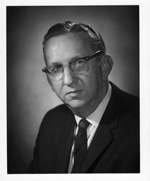Profile of Wendell Mordy, former cellist with the Argenta Trio Conducted by Forrest Hartman
Years with Argenta: 1961 - 1965 Wendell Mordy is best remembered as a scientist, but he was also a musician through and through. In fact his widow, Brooke Mordy, says he might have become a professional cellist had a few things turned out differently. “He liked both science and music, and he had studied cello from the time he was 11,” Brooke said. “He studied with good teachers all through high school and college.” Wendell was such a fine musician that he became the first cellist for the University of Nevada, Reno piano trio even though he wasn’t part of the music department. When the trio formed, the department had only five faculty members, none of whom were cellists. That meant pianist Ron Williams and violinist Harold “Rusty” Goddard were on the hunt for a third player. They found one in Wendell, who came to UNR in 1960 as founding director of the Desert Research Institute. “We always had chamber music in our home just for fun,” she said. “He would always find people to play with wherever we lived. We were in Honolulu for a time, and he played with the Honolulu Symphony.” At that time, the orchestra was semi-professional, but it later went fully professional. When Wendell came to Reno, Williams said, he and Goddard were pleased. “It was always a very good experience with the three of us,” Williams said. “Wendell could play awfully well… He was very musical, and he was very serious about what he was doing.” Wendell was also particularly well schooled for an “amateur” musician. While in high school in Des Moines, Iowa, he made monthly trips to Minneapolis to study with Frank Miller who was principal cellist of the Minneapolis Symphony. Then, after leaving Iowa to pursue a science degree at Pomona College in California, he continued his studies with Axel Simonson of the Los Angeles Philharmonic. “He had been very well trained, and he was very serious about his playing,” Williams said. “It wasn’t just something that he tossed out as pure recreation.” Wendell did, however, play for the love of it. That was a requirement in the early days of the UNR Trio because none of the players were allotted school time or money for practices and performances. Nevertheless, Wendell, Williams and Goddard got together regularly, playing mostly chestnuts by the likes of Beethoven and Mozart. “It began as a social thing, and then we began performing for various groups,” Williams said. “Our families were really very compatible.” That was important because the trio of the early 1960s relied entirely on the devotion of the players and their spouses. “The rehearsals were in our various homes,” Brooke said. “I went to most.” When he wasn’t playing music, Wendell was dedicated to his life as a scientist and administrator. He was always interested in weather, and he served as a meteorologist in the U.S. Army Air Corps during World War II. After the war, he worked in meteorology for Pan American World Airways and the U.S. Weather Bureau before landing a job as head of the Department of Meteorology at the Pineapple Research Institute and Experiment Station in Honolulu, Hawaii. While in Hawaii, he conducted weather research for both the Pineapple Institute and the Sugar Planters’ Association. In 1956, Wendell left Hawaii and earned a doctorate in meteorology from the University of Stockholm in Sweden. Then, came his 10-year stop in Nevada and his association with the UNR Trio. Williams said Wendell’s schedule was tight because of his commitment to the DRI, but he always found time to fully prepare for practices. Williams also remembers one funny story where Wendell’s two lives overlapped. “Shortly after Wendell came, they built the Planetarium (now called Fleischmann Planetarium),” Williams said. “We were rehearsing at his house, and he received a phone call. He came back red faced and said, ‘I’ve got to leave.’ He was swearing under his breath. He said, ‘Some blankety blank has driven his Jeep across the roof of the Planetarium. He was absolutely furious.’” Brooke said Wendell was protective of the facility, originally known as the Atmospherium-Planetarium, because it was built on his initiative and featured the then-new idea of whole-sky movie projection on a dome. Despite Wendell’s initial anger, Williams said he was laughing about the Jeep incident before he left practice. Two weeks later, barriers were installed to prevent the same thing from happening again. Wendell played with the UNR trio from 1961 to 1965, leaving only after the music department hired Geoffrey Rutkowski. “Geoff was brought in specifically as a cellist,” Williams said, “and the DRI had really expanded to such an extent that it was, I think, kind of hard on Wendell to keep up his music to the level he would want to.” Brooke said that was indeed the case. “He was fine doing both things for awhile,” she said. “But he had to travel a lot, and he couldn’t make enough rehearsals.” Even after leaving the trio, Wendell and Brooke attended concerts and supported the group. She said he also maintained his playing as best he could, even taking on the occasional student. In 1970, he left Nevada, and in 1977 he settled in as president of the Science Museum of Minnesota. Wendell stayed in that position until his retirement in 1985, and he lived in St. Paul until his death in 2002. One of Wendell’s obituaries describes him as a Renaissance man, and it notes that he saw no chasm between the two fields that he loved so dearly. “In his mind,” the article reads, “science and art merged together in one grand tapestry.” For more information on Wendell Mordy and his work, see the following links from Iowa State University, American Heritage and the Niels Bohr Library & Archives. |
 Name: Wendell Mordy
Name: Wendell Mordy